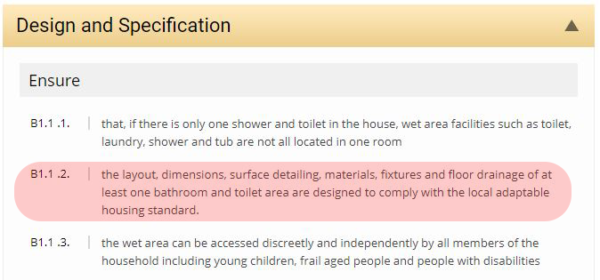NEWS/ADVOCACY: Minimum standards for NSW accessible housing – NOT ADOPTED
You might remember our February news item on the “Building Better Homes” initiative to see mandatory minimum accessibility requirements of ‘gold’ brought into the National Construction Code (NCC).
In April 2021, NSW Building Ministers met with a majority agreement to include minimum ‘silver’ accessibility provisions, and in July 2021 this was revoked. Victoria, Queensland, Tasmania, ACT and NT all agreed to support the change.
There are three levels of performance in the Livable Housing Design Guidelines
The integration of such a regulatory solution in the NCC would improve accessible housing stock, ensuring design for longevity of access for tenants and hence health, and also avoiding more costly home modifications at a later date. This agreement would have meant all residential housing and apartments must be designed according to the Livable Housing Design Guidelines (LHDG) lowest tier; ‘silver’ standard. ‘silver’ standard means designed and constructed elements such as:
- At least one, level (step-free) entrance into the dwelling
- Internal doors and corridors that facilitate comfortable and unimpeded movement between spaces
- A bathroom that contains a hobless shower recess
- Reinforced walls around the toilet, shower and bath to support the safe installation of grabrails at a later date
The CEO from Council on the Ageing wrote to the minister Kevin Anderson MP (of Better Regulation and Innovation), regarding their concern over the decision, with a response including; “…the NSW Government does not support the inclusion of minimum accessibility standards in the NCC as currently proposed. The changes will have negative impacts on housing affordability and the construction sector, and will also come at a significant cost to the community…”
Others writing on this topic…
Centre for Universal Design Australia have written an article on this topic, agreeing ‘this decision is perplexing.’
This doesn’t stop you…
The Livable Housing Design Guidelines are open source and available through Livable Housing Australia and are currently an optional inclusion into all construction. They are a great resource when thinking about designing for longevity and inclusion. Platinum level provides the highest level of accessibility and livability.
Is Accessibility a part of Housing for Health: The Guide?
‘Accessibility’ is integrated throughout The Guide.
Under ‘Design and Specification’ for each HLP you will find points outlining requirements and considerations. For example under Wet Area Design, it is a requirement to ensure:

Snippet from The Guide: Wet Area Design – B1.1.2
And, encouraged to ‘Consider’ many points, including:
- designing all wet areas so that they can be easily adapted to allow frail aged people or people with disabilities full access to, and use of, wet areas
- designing wet area floors to fall in a single direction to provide a more even surface for people who are frail aged or with disabilities
Under ‘Standard and References’ at the bottom of each page of The Guide are outlined many Australian Standards and NCC requirements to reference when planning and designing, including for example AS 1428.1, Design for access and mobility—General requirements for access—New building work.
Healthabitat thinks that it is a shame this was not adopted nation wide. It is cheaper to build accessible housing from the outset than to retrofit houses at a later date. This puts the burden back on the people who require this to ‘make-do’ and removes choice for people wanting to live independently.










